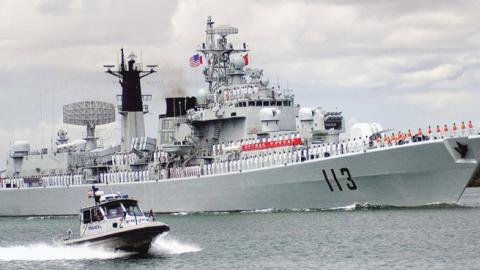In its long history, China has deployed substantial naval power, but only episodically. It never faced sustained naval threats, so the country’s maritime frontier was not a perennial strategic concern. But in more modern times, seaborne pressures from the Western powers and Japan became unremitting. Foreign navies even sailed deep into the country’s interior, establishing “treaty ports” hundreds of miles from the coast. This ended with the establishment of the People’s Republic of China in 1949. Still, even though Western naval power was pushed offshore, seaborne forces nearby could attack China with impunity.
This rankled, but what to do? In 1965, Marshal Lin Biao (perhaps Chairman Mao’s closest comrade in arms) looked to the earlier defeat of Japan by the once-tiny People’s Liberation Army (PLA) to ask, “How was it possible for a weak country finally to defeat a strong country?” His answer was found in Mao Zedong’s idea of “People’s War.” Although land based, the concept held promise for menacing forward naval positions of the United States, perceived
as the foremost opponent. Having backed an insurgency in the Philippines, a coup attempt in Indonesia, and guerilla wars in Malaya and Vietnam, Beijing could imagine pushing the United
States out of great anchorages such as Subic, Cam Rahn, and Singapore. As for Yokosuka, Japan—the U.S. Navy’s most important base in the western Pacific—a successful political campaign
might chase the United States four thousand miles east, back to Honolulu.
This was naval warfare de facto, but it did not succeed. In the end, China learned that American sea power could not be neutralized on the cheap. However, China began to rise economically through its seaborne connections, and in the 1980s Admiral Liu Huaqing—sometimes called “China’s Mahan”—made a case for a strong navy. This vision was realized more fully in 2012 when Communist Party leader Hu Jintao announced a new national goal: “to enhance our capacity for exploiting marine resources, develop the marine economy, protect the marine maritime rights and interests, and build China into a strong maritime power.”
During this same period of an economically rising China, the Naval War College’s China Maritime Studies Institute became a leading center for analyzing China’s naval power. Two of the Institute’s mainstays, Andrew Erickson and Ryan Martinson, again have contributed to our understanding by assembling and editing twenty papers prepared for a 2017 conference on what could turn out to be the most significant component of China’s modus operandi at sea: exploitation of the so-called gray zone.
This anthology reminds us that the naval battle with China already is underway, and that it is about more than big ships, aircraft, and submarines. The PLA Navy, which certainly likes to show off its new fleet, also relies on a coast guard, fishing boats, and maritime militia, which are perfectly suited for a gray-zone space of neither war nor peace. As a result, China has succeeded in enclosing and then militarizing areas once thought of as high seas. China, in best Leninist fashion, continues to probe and push, encountering “mush” instead of the steel of real resistance.
This is certainly not “decisive naval battle–ism,” nor is it quite “people’s war at sea.” Still, Mao’s dicta echo: a struggle is 10 percent military / 90 percent political; avoid the decisive encounter until the very last moment; and, above all, protract, to enable one to build from weakness to strength. Soon after becoming a Communist Party leader in 2013, Xi Jinping told his comrades in a private speech that China would remain weaker than the West for some time. China’s naval operations in the maritime gray zone—patient, purposeful, relentless— embody Maoist patience, buying time to maneuver from a position of relative weakness to one of strength.
The papers collected in this new work, China’s Maritime Gray Zone Operations, can help us better understand this maneuvering and meet the challenges the West already faces—challenges that only will grow as China’s naval strength and presence grow.
Read in Naval War College Review

















